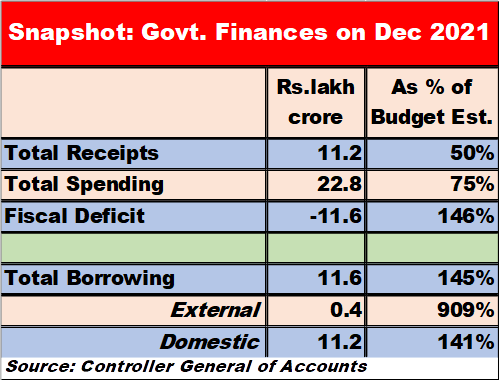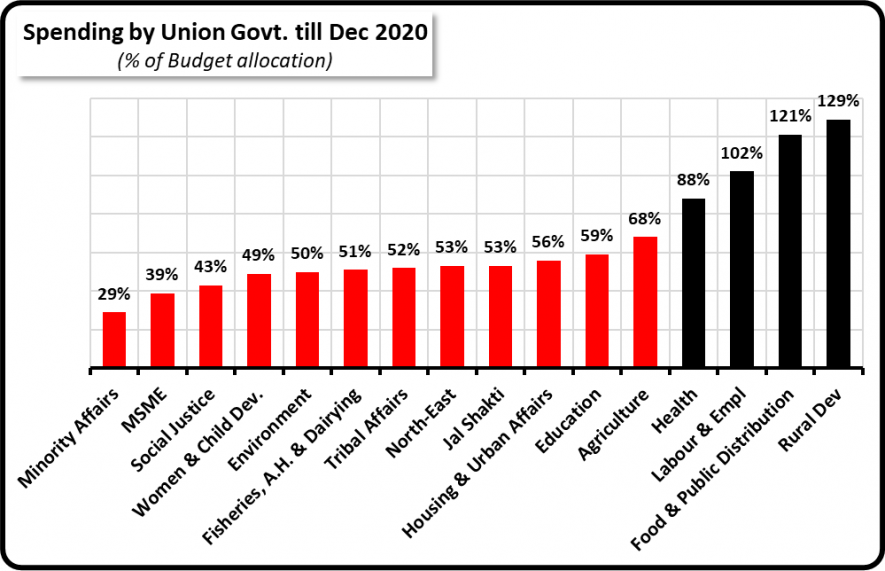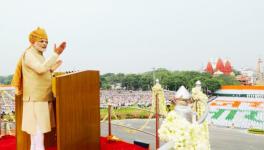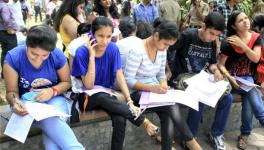Before Budget: Revenues Crash, Debt Mounts – But People Still Deprived
When the Union Budget is presented tomorrow (February 1), the government will have its hands full and pockets empty. In the current financial year, which will end on March 31, currently available information shows that revenues (government income) are going to be much short of what was estimated in last year’s Budget estimates. Spending is likely to be short of target, too, but it will be more than the income. This creates what is the biggest bug bear for today’s economists – a huge gap called fiscal deficit.
The government appears to have borrowed heavily to fill this gap, leaving the country enormously weighed down by debt. But strangely, this has not meant that spending on people’s welfare has gone up substantially. In a year when the people’s back was broken by the pandemic and the ill-conceived lockdown of the economy, the government has slashed spending on key necessities, and refused to spend money to mitigate the closure of the economy for agonisingly long months. This heartless approach is bound to be reflected in the Budget, too.
Revenue Shortfall, Debt Mounting
First have a look at the government’s finances in summary form, as available till December 2020, from the Controller General of Accounts (CGA), the official body that monitors government accounts, under the finance ministry. As can be seen in the table below, total receipts (or income) of the government from taxes, interest, etc. amounted to about Rs.11.2 lakh crore. This was just half of what the Budget had estimated for the year. Since this is for December, with three months still left, receipts will go up further. But surely, these can’t make up the remaining 50% in three months.

Spending, on the other side, has been over twice the receipts, at Rs.22.8 lakh crore. This is 75% of the Budget estimates, which is as it should be with three quarters of the year over. But here is the thing: it should have been more because after all, this was an exceptionally tough year, with the pandemic lockdown devastating the lives and livelihoods of crores of people. How this has been managed, we will see a little later.
The gap between receipts and spending – the fiscal deficit – thus works out to about Rs.11.6 lakh crore. Remember that this is in December 2020. It may go down or maybe not, in the remaining three months.
So, how does the government bridge this gap? Before that, it should be understood that it is not necessary to bridge the gap – we are talking about a sovereign entity, not a corporation or household. The government can maintain a gap and use its other resources to meet spending needs. But that is anathema to current day mainstream economists, and the Narendra Modi government is immersed in this ideology.
So, the government bridged the gap – by borrowing. As you can see in the table above, the books have been balanced by showing an equal amount of Rs.11.6 lakh crore borrowed from two types of sources. One is foreign banks and institutions, which lent some Rs.42,000 crore, and the other is domestic borrowing – from Indian banks, and from various other domestic sources, such as provident funds, various small savings schemes, etc. All this is returnable – but that’s for another day.
One should also remember that some other tricks, too, are up the sleeves of wizards in the finance ministry. For example, take the case of food subsidy, which is the amount the government pays to provide cheap foodgrain through the public distribution system or PDS. The work is actually done by the Food Corporation of India (FCI), and the government has allowed a huge backlog of payments to pile up on FCI’s shoulders, keeping its own books clean. These are called off-Budget accounts. Despite such sleights of hand, there is a mountain of debt facing India.
Ministries Faced Spending Cuts
But, it might be argued, that this was needed to meet the challenge of the pandemic and the locked economy. That would have been true – except that the ministry-wise data on spending – again available with CGA – tells a different story. This can be seen in the chart below.

Till December 2020, ministries and departments should have, roughly speaking, spent three-fourth or 75% of their allocated funds. But as you can see in the chart, the most important ministries that manage schemes meant for welfare of disadvantaged sections or regions, have barely spent half the funds. The health ministry has spent 88% of its allocated funds, which is to be expected given the pandemic.
Some of the schemes announced by the government during the pandemic were routed through relevant ministries. So, their spending has gone up considerably. For example Rs.40,000 crore additional allocation was given to the rural development ministry for the rural jobs guarantee scheme (MGNREGS), several thousand crore rupees were spent on giving additional foodgrain in the lockdown months – this goes into the accounts of the food and public distribution department.
What is striking in this is that the government has spent more on some heads – but slashed routine spending under all other heads. Thus, the social justice ministry, which deals with such important schemes as pre- and post-matric scholarships for Scheduled Caste/Scheduled Tribe students, has spent just 43% of its allocated amount!
The minority affairs ministry, which runs schemes for the development of the deprived sections among minorities, has spent a mere 29% of its funds. The women and child development ministry, which runs the important anganwadi system for nutrition to infants, has not spent even 50% of its funds. Even the ministry that deals with micro, small and medium enterprises (MSME), which provides employment to a large number of people and which suffered the greatest devastation in the lockdown, has not even spent 40% of its funds.
It is not as if these ministries are taking decisions on their own not to spend. It is known that their purse strings are controlled by the finance ministry and they must have guided this miserly approach.
In short, the government appears to have spent some amounts on some schemes but it has cut down on others. Seen in the context of the huge debt it has accumulated, this is all the more bizarre. When the Budget is presented, the revised estimates of spending (which are near to the actuals) will be revealed. But this year, there is bound to be gaps if the December figures discussed above are anything to go by. And we will also see the wild claims of a ‘V-shaped recovery’ in the coming year, with all these glaring holes hidden away behind the rhetoric.
Get the latest reports & analysis with people's perspective on Protests, movements & deep analytical videos, discussions of the current affairs in your Telegram app. Subscribe to NewsClick's Telegram channel & get Real-Time updates on stories, as they get published on our website.
























